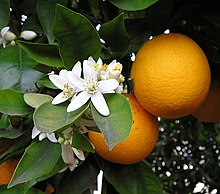From Wikipedia, the free encyclopedia
This article is about the fruit. For the colour, see Orange (colour). For the painting also called "Orange Trees", see Les Orangers. For other uses, see Orange (disambiguation).

An orange, whole and split

Orange blossoms and oranges on tree

Oranges and orange juice
The orange (specifically, the sweet orange) is the fruit of the citrus species Citrus × sinensis in the family Rutaceae.[1]
The fruit of the Citrus × sinensis is considered a sweet orange, whereas the fruit of the Citrus × aurantium is considered a bitter orange. The sweet orange reproduces asexually (apomixis through nucellar embryony); varieties of sweet orange arise through mutations.[2]
The orange is a hybrid, between pomelo (Citrus maxima) and mandarin (Citrus reticulata). It has genes that are ~25% pomelo and ~75% mandarin;[2][3] however, it is not a simple backcrossed BC1 hybrid, but hybridized over multiple generations.[4] The chloroplast genes, and therefore the maternal line, seem to be pomelo.[2] The sweet orange has had its full genome sequenced.[2] Earlier estimates of the percentage of pomelo genes varying from ~50% to 6% have been reported.[3]
Sweet oranges were mentioned in Chinese literature in 314 BC.[2] As of 1987, orange trees were found to be the most cultivated fruit tree in the world.[5] Orange trees are widely grown in tropical and subtropical climates for their sweet fruit. The fruit of the orange tree can be eaten fresh, or processed for its juice or fragrant peel.[6] As of 2012, sweet oranges accounted for approximately 70% of citrus production.[7]
In 2013, 71.4 million metric tons of oranges were grown worldwide, production being highest in Brazil and the U.S. states of Florida and California.[8]
https://en.wikipedia.org/wiki/Orange_(fruit)